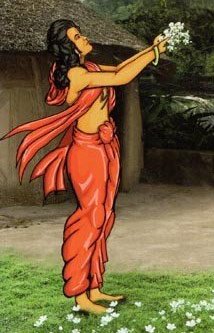Ravanaganga, Rāvaṇagaṅga, Rāvaṇagaṅgā, Ravana-ganga: 5 definitions
Introduction:
Ravanaganga means something in Hinduism, Sanskrit. If you want to know the exact meaning, history, etymology or English translation of this term then check out the descriptions on this page. Add your comment or reference to a book if you want to contribute to this summary article.
In Hinduism
Kavya (poetry)
Source: Shodhganga: The Kavyamimamsa of RajasekharaRāvaṇagaṅga (रावणगङ्ग) is the name a locality mentioned in Rājaśekhara’s 10th-century Kāvyamīmāṃsā.—In is the south Indian river to Rājaśekhara. However, it is difficult to identify this river but it was situated in Ceylon or the Laṅkā of Rāvana. The Rāvanahṛada situated in the Himālayas with an image of Rāvana on its bank seems. Though it is to be different from this Rāvanagaṅgā.

Kavya (काव्य, kavya) refers to Sanskrit poetry, a popular ancient Indian tradition of literature. There have been many Sanskrit poets over the ages, hailing from ancient India and beyond. This topic includes mahakavya, or ‘epic poetry’ and natya, or ‘dramatic poetry’.
Languages of India and abroad
Sanskrit dictionary
Source: DDSA: The practical Sanskrit-English dictionaryRāvaṇagaṅgā (रावणगङ्गा).—Name of a river in Laṅkā.
Rāvaṇagaṅgā is a Sanskrit compound consisting of the terms rāvaṇa and gaṅgā (गङ्गा).
Source: Cologne Digital Sanskrit Dictionaries: Monier-Williams Sanskrit-English DictionaryRāvaṇagaṅgā (रावणगङ्गा):—[=rāvaṇa-gaṅgā] [from rāvaṇa > rāva] f. ‘R°’s Ganges’, Name of a river in Laṅka, [Gāruḍa-purāṇa]
[Sanskrit to German]
Sanskrit, also spelled संस्कृतम् (saṃskṛtam), is an ancient language of India commonly seen as the grandmother of the Indo-European language family (even English!). Closely allied with Prakrit and Pali, Sanskrit is more exhaustive in both grammar and terms and has the most extensive collection of literature in the world, greatly surpassing its sister-languages Greek and Latin.
See also (Relevant definitions)
Relevant text
Search found 2 books and stories containing Ravanaganga, Rāvaṇagaṅga, Rāvaṇagaṅgā, Ravana-ganga, Rāvaṇa-gaṅgā; (plurals include: Ravanagangas, Rāvaṇagaṅgas, Rāvaṇagaṅgās, gangas, gaṅgās). You can also click to the full overview containing English textual excerpts. Below are direct links for the most relevant articles:
Kavyamimamsa of Rajasekhara (Study) (by Debabrata Barai)
Part 8.5 - Region of Dakṣiṇāpatha (southern part) < [Chapter 5 - Analyasis and Interpretations of the Kāvyamīmāṃsā]
Appendix 2 - Identification of Geographical names mentioned in the Kāvyamīmāṃsā
The Garuda Purana (by Manmatha Nath Dutt)
Chapter LXX - Tests of Ruby < [Agastya Samhita]